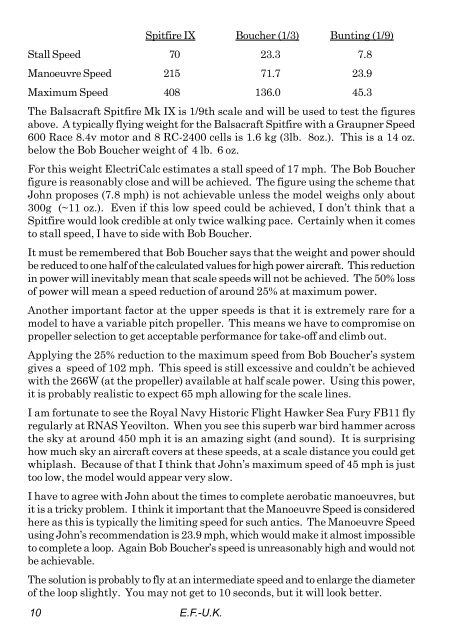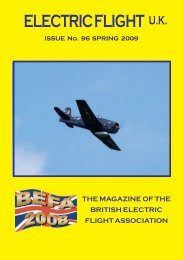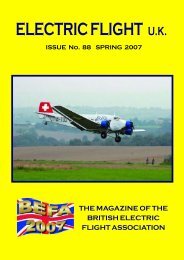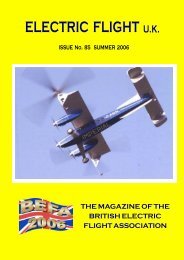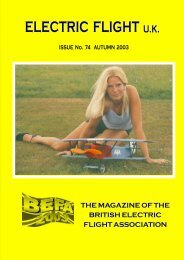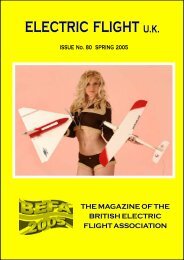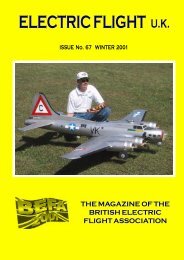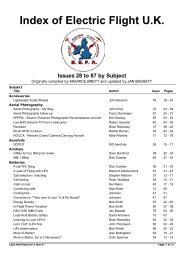electric flight uk - British Electric Flight Association - Jan Bassett's
electric flight uk - British Electric Flight Association - Jan Bassett's
electric flight uk - British Electric Flight Association - Jan Bassett's
Create successful ePaper yourself
Turn your PDF publications into a flip-book with our unique Google optimized e-Paper software.
Spitfire IX Boucher (1/3) Bunting (1/9)<br />
Stall Speed 70 23.3 7.8<br />
Manoeuvre Speed 215 71.7 23.9<br />
Maximum Speed 408 136.0 45.3<br />
The Balsacraft Spitfire Mk IX is 1/9th scale and will be used to test the figures<br />
above. A typically flying weight for the Balsacraft Spitfire with a Graupner Speed<br />
600 Race 8.4v motor and 8 RC-2400 cells is 1.6 kg (3lb. 8oz.). This is a 14 oz.<br />
below the Bob Boucher weight of 4 lb. 6 oz.<br />
For this weight ElectriCalc estimates a stall speed of 17 mph. The Bob Boucher<br />
figure is reasonably close and will be achieved. The figure using the scheme that<br />
John proposes (7.8 mph) is not achievable unless the model weighs only about<br />
300g (~11 oz.). Even if this low speed could be achieved, I don’t think that a<br />
Spitfire would look credible at only twice walking pace. Certainly when it comes<br />
to stall speed, I have to side with Bob Boucher.<br />
It must be remembered that Bob Boucher says that the weight and power should<br />
be reduced to one half of the calculated values for high power aircraft. This reduction<br />
in power will inevitably mean that scale speeds will not be achieved. The 50% loss<br />
of power will mean a speed reduction of around 25% at maximum power.<br />
Another important factor at the upper speeds is that it is extremely rare for a<br />
model to have a variable pitch propeller. This means we have to compromise on<br />
propeller selection to get acceptable performance for take-off and climb out.<br />
Applying the 25% reduction to the maximum speed from Bob Boucher’s system<br />
gives a speed of 102 mph. This speed is still excessive and couldn’t be achieved<br />
with the 266W (at the propeller) available at half scale power. Using this power,<br />
it is probably realistic to expect 65 mph allowing for the scale lines.<br />
I am fortunate to see the Royal Navy Historic <strong>Flight</strong> Hawker Sea Fury FB11 fly<br />
regularly at RNAS Yeovilton. When you see this superb war bird hammer across<br />
the sky at around 450 mph it is an amazing sight (and sound). It is surprising<br />
how much sky an aircraft covers at these speeds, at a scale distance you could get<br />
whiplash. Because of that I think that John’s maximum speed of 45 mph is just<br />
too low, the model would appear very slow.<br />
I have to agree with John about the times to complete aerobatic manoeuvres, but<br />
it is a tricky problem. I think it important that the Manoeuvre Speed is considered<br />
here as this is typically the limiting speed for such antics. The Manoeuvre Speed<br />
using John’s recommendation is 23.9 mph, which would make it almost impossible<br />
to complete a loop. Again Bob Boucher’s speed is unreasonably high and would not<br />
be achievable.<br />
The solution is probably to fly at an intermediate speed and to enlarge the diameter<br />
of the loop slightly. You may not get to 10 seconds, but it will look better.<br />
10 E.F.-U.K.


